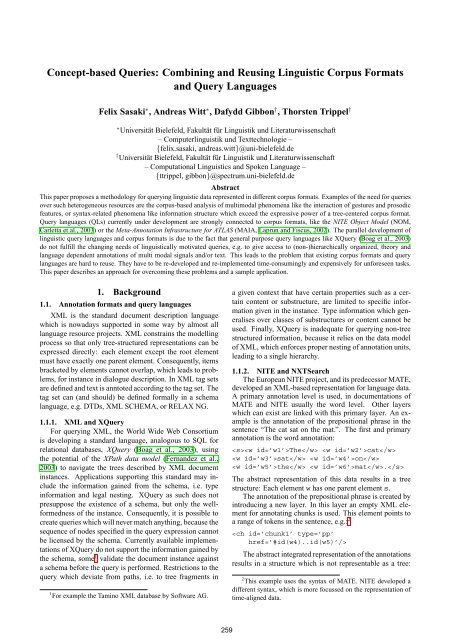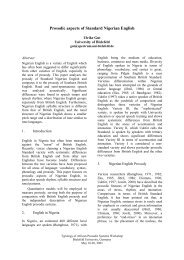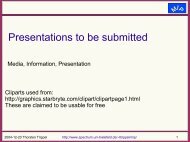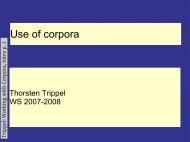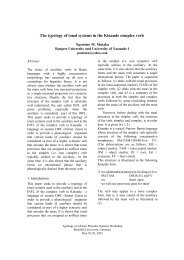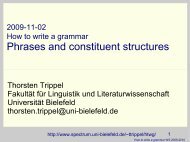download pdf file - Computational Linguistics and Spoken ...
download pdf file - Computational Linguistics and Spoken ...
download pdf file - Computational Linguistics and Spoken ...
Create successful ePaper yourself
Turn your PDF publications into a flip-book with our unique Google optimized e-Paper software.
Concept-based Queries: Combining <strong>and</strong> Reusing Linguistic Corpus Formats<br />
<strong>and</strong> Query Languages<br />
Felix Sasaki ∗ , Andreas Witt ∗ , Dafydd Gibbon † , Thorsten Trippel †<br />
∗ Universität Bielefeld, Fakultät für Linguistik und Literaturwissenschaft<br />
– Computerlinguistik und Texttechnologie –<br />
{felix.sasaki, <strong>and</strong>reas.witt}@uni-bielefeld.de<br />
† Universität Bielefeld, Fakultät für Linguistik und Literaturwissenschaft<br />
– <strong>Computational</strong> <strong>Linguistics</strong> <strong>and</strong> <strong>Spoken</strong> Language –<br />
{ttrippel, gibbon}@spectrum.uni-bielefeld.de<br />
Abstract<br />
This paper proposes a methodology for querying linguistic data represented in different corpus formats. Examples of the need for queries<br />
over such heterogeneous resources are the corpus-based analysis of multimodal phenomena like the interaction of gestures <strong>and</strong> prosodic<br />
features, or syntax-related phenomena like information structure which exceed the expressive power of a tree-centered corpus format.<br />
Query languages (QLs) currently under development are strongly connected to corpus formats, like the NITE Object Model (NOM,<br />
Carletta et al., 2003) or the Meta-Annotation Infrastructure for ATLAS (MAIA, Laprun <strong>and</strong> Fiscus, 2002). The parallel development of<br />
linguistic query languages <strong>and</strong> corpus formats is due to the fact that general purpose query languages like XQuery (Boag et al., 2003)<br />
do not fulfill the changing needs of linguistically motivated queries, e.g. to give access to (non-)hierarchically organized, theory <strong>and</strong><br />
language dependent annotations of multi modal signals <strong>and</strong>/or text. This leads to the problem that existing corpus formats <strong>and</strong> query<br />
languages are hard to reuse. They have to be re-developed <strong>and</strong> re-implemented time-consumingly <strong>and</strong> expensively for unforeseen tasks.<br />
This paper describes an approach for overcoming these problems <strong>and</strong> a sample application.<br />
1. Background<br />
1.1. Annotation formats <strong>and</strong> query languages<br />
XML is the st<strong>and</strong>ard document description language<br />
which is nowadays supported in some way by almost all<br />
language resource projects. XML constrains the modelling<br />
process so that only tree-structured representations can be<br />
expressed directly: each element except the root element<br />
must have exactly one parent element. Consequently, items<br />
bracketed by elements cannot overlap, which leads to problems,<br />
for instance in dialogue description. In XML tag sets<br />
are defined <strong>and</strong> text is anntoted according to the tag set. The<br />
tag set can (<strong>and</strong> should) be defined formally in a schema<br />
language, e.g. DTDs, XML SCHEMA, or RELAX NG.<br />
1.1.1. XML <strong>and</strong> XQuery<br />
For querying XML, the World Wide Web Consortium<br />
is developing a st<strong>and</strong>ard language, analogous to SQL for<br />
relational databases, XQuery (Boag et al., 2003), using<br />
the potential of the XPath data model (Fern<strong>and</strong>ez et al.,<br />
2003) to navigate the trees described by XML document<br />
instances. Applications supporting this st<strong>and</strong>ard may include<br />
the information gained from the schema, i.e. type<br />
information <strong>and</strong> legal nesting. XQuery as such does not<br />
presuppose the existence of a schema, but only the wellformedness<br />
of the instance. Consequently, it is possible to<br />
create queries which will never match anything, because the<br />
sequence of nodes specified in the query expression cannot<br />
be licensed by the schema. Currently available implementations<br />
of XQuery do not support the information gained by<br />
the schema, some 1 validate the document instance against<br />
a schema before the query is performed. Restrictions to the<br />
query which deviate from paths, i.e. to tree fragments in<br />
1 For example the Tamino XML database by Software AG.<br />
a given context that have certain properties such as a certain<br />
content or substructure, are limited to specific information<br />
given in the instance. Type information which generalises<br />
over classes of substructures or content cannot be<br />
used. Finally, XQuery is inadequate for querying non-tree<br />
structured information, because it relies on the data model<br />
of XML, which enforces proper nesting of annotation units,<br />
leading to a single hierarchy.<br />
1.1.2. NITE <strong>and</strong> NXTSearch<br />
The European NITE project, <strong>and</strong> its predecessor MATE,<br />
developed an XML-based representation for language data.<br />
A primary annotation level is used, in documentations of<br />
MATE <strong>and</strong> NITE usually the word level. Other layers<br />
which can exist are linked with this primary layer. An example<br />
is the annotation of the prepositional phrase in the<br />
sentence “The cat sat on the mat.”. The first <strong>and</strong> primary<br />
annotation is the word annotation:<br />
The cat<br />
sat on<br />
the mat.<br />
The abstract representation of this data results in a tree<br />
structure: Each element w has one parent element s.<br />
The annotation of the prepositional phrase is created by<br />
introducing a new layer. In this layer an empty XML element<br />
for annotating chunks is used. This element points to<br />
a range of tokens in the sentence, e.g.: 2<br />
<br />
The abstract integrated representation of the annotations<br />
results in a structure which is not representable as a tree:<br />
2 This example uses the syntax of MATE. NITE developed a<br />
different syntax, which is more focussed on the representation of<br />
time-aligned data.<br />
259
The word elements with the ids 4, 5, <strong>and</strong> 6 have two parents,<br />
s <strong>and</strong> the element ch. Within the data model of NITE<br />
this representation is possible because it supports multiple<br />
intersecting hierarchies. Consequently, the query language<br />
of NITE (NiteQL) which is implemented in the NXT-<br />
Search Toolkit allows for quering of more complex structures<br />
than those permitted by XQuery.<br />
1.1.3. AGs<br />
The Annotation Graph Model (Bird <strong>and</strong> Liberman,<br />
2001) defines a formal model for the interpretation of annotations<br />
in graph form. In the domain of speech annoation,<br />
this is done by the use of a reference to the timeline as a<br />
constant. For multiple annotations of primary data (Witt,<br />
2002) a similar annotation model is achieved by using a<br />
primary level of annotation as an anchoring level. For example,<br />
the sequence of characters in textual data can supply<br />
the information about absolute ordering which is necessary<br />
for the anchoring.<br />
Part of the annotation graph model is a formal description<br />
of a query language for these graphs, cf. Bird et al.,<br />
2000, with a query syntax. This is a very general model<br />
describing the properties of a query for a given annotation<br />
graph. The query is described in terms of a restricted selection<br />
from a set of arcs of an annotation graph, taking into<br />
account relations between the different arcs, such as overlaps,<br />
sequence, etc. No implementation is given.<br />
For a database programmer familiar with SQL the individual<br />
constructs seem obvious, but this is not true for<br />
practical research queries. Researchers do not necessarily<br />
have the graph structure of annotations in mind when<br />
formulating queries based on more than one level of annotation.<br />
Consequently an intermediate level of querying is<br />
needed where general queries are mapped onto the graph<br />
based queries that can be executed in various data structures.<br />
1.2. Modelling<br />
1.2.1. Document grammars<br />
Document grammars are used for defining XMLelements<br />
<strong>and</strong> their attributes <strong>and</strong> content models. By defining<br />
a content model it is possible to constrain which elements<br />
must, may, or must not occur as the content of an<br />
element. Furthermore a content model constrains the sequence<br />
of the legitimate elements, the type of the attributes<br />
(<strong>and</strong>, depending on the schema language, the elements). In<br />
addition some schema languages allow for the definition of<br />
‘fixed’ or default values of attributes.<br />
An XML document which is validated against a document<br />
grammar is known to have a certain structure. This<br />
information can help to speed up the process of querying,<br />
for example because it is not necessary to search for a certain<br />
element in a certain substructure if the schema does<br />
not permit the element in this substructure. This option is<br />
apparently not used in implementations of QLs of this type.<br />
1.2.2. Multiple annotations<br />
There are several techniques available for annotating<br />
language <strong>and</strong> speech data on multiple layers. The approaches<br />
mentioned above (i.e. MATE/Nite <strong>and</strong> AGs) use a<br />
hyperlink-based technique, where layers are interconnected<br />
through links. An alternative to this is to use of multiple<br />
(e.g. st<strong>and</strong>-off) annotations of the same textual base (Witt,<br />
2002). This approach offers a lot of advantages: It allows<br />
for structuring text according to multiple concurrent document<br />
grammars without workarounds. Furthermore additional<br />
annotations can be subsequently included without<br />
changing already established annotations. For example, the<br />
hyperlink-based technique could make it necessary to introduce<br />
new anchor elements in the primary annotation layer if<br />
a new layer should be introduced. In using multiple annotations,<br />
the layers are independent of each other. Nonetheless<br />
they are interrelated, namely via the text. This allows on<br />
the one h<strong>and</strong> for inferences of relations between different<br />
annotation layers (Bayerl et al., 2003). On the other h<strong>and</strong><br />
relations between levels (see below) <strong>and</strong> layers can be expressed<br />
in a formal way.<br />
2. The LCD approach<br />
We claim that an LCD approach allows for querying<br />
<strong>and</strong> expressing relations both in a single layer <strong>and</strong> between<br />
multiple annotated layers. As a solution to the problems of<br />
corpus formats <strong>and</strong> query languages described above, we<br />
consequently propose an abstract, conceptual level called<br />
“Linguistic Concept Descriptions” (LCD) which is built on<br />
top of the existing formats <strong>and</strong> query languages. Linguistic<br />
concepts, i.e. linguistic categories, principles etc. are declared<br />
in an LCD, which is separated from the query mechanisms<br />
<strong>and</strong> which can be used to retrieve instances of a concept<br />
in corpora. The linguistic concepts are organized in<br />
disjoint sets: for a specific language, linguistic theory or<br />
domain, a separate LCD is created, for example an LCD<br />
which encompasses concepts for an HPSG-grammar fragment<br />
of Japanese. Since an LCD encompasses a closed set<br />
of concepts, a generic mapping function from an LCD to<br />
query expressions in various query languages <strong>and</strong> their underlying<br />
corpus formats can be created. There are several<br />
advantages of this approach:<br />
1. If the mapping function has been specified once, there<br />
is no need for the end-user to deal with the underlying<br />
corpus formats or query languages.<br />
2. Various corpus formats can be used simultaneously.<br />
As a result of a uniform query, instances are retrieved<br />
from data in different corpus formats.<br />
3. Since the same set of concepts can be instantiated<br />
in several corpus formats, the need to develop new<br />
query languages can be reduced. For unforeseen use<br />
cases, i.e. the integration of new linguistic categories<br />
in the HPSG-grammar model, 3 existing corpus-data<br />
<strong>and</strong> query-tools can be reused.<br />
3. Properties of an LCD<br />
The properties of an LCD are described with reference<br />
to Figure 1. An LCD consists of a set of<br />
models, e.g. PhrasalStructure <strong>and</strong> concepts, e.g.<br />
3 It could be desirable to introduce a MORPH feature on lexical<br />
signs to treat various kinds of morphological phenomena that are<br />
irrelevant in syntax. See Krieger, 1993; Lüngen, 2002<br />
260
Sentence. The concepts are arguments of predicates.<br />
That is, an LCD is a set of logical statements<br />
which can be written in a straightforward notation of<br />
triples. Concepts are arguments of the predicate partOf,<br />
e.g. Sentence partOf PhrasalStructure. In<br />
this way, disjointness of models becomes explicit.<br />
Subordinated concepts are arguments of the predicate<br />
subClassOf, e.g. Non-embeddedVerbalPhrase<br />
subClassOf VerbalPhrase. To be able to operationalize<br />
an LCD, only proper parts <strong>and</strong> subclasses are<br />
permitted so that the statements must not lead to a cyclic<br />
structure: e.g. a statement like Sentence subClassOf<br />
Sentence. is not allowed.<br />
Figure 1: Properties of an Linguistic Concept Description.<br />
In terms of Sowa, 1996 (cited after Fischer, 1998) this<br />
structure can be described as a terminological ontology.<br />
The statements create subtype, supertype <strong>and</strong> partOf relations.<br />
An important aspect of such an ontology is the intensional<br />
<strong>and</strong> extensional notion of subsumption. Intensionally<br />
speaking, there has to be a singular interpretation of the<br />
concept hierarchy; for example, a concept must not be subordinated<br />
to itself. Extensionally speaking, subordinated<br />
concepts share the properties, i.e. predicates of superordinated<br />
concepts, <strong>and</strong> the instances of the concepts. In the<br />
case of an LCD, the instances are to be found in corpus<br />
data. To create the extensional interpretation of an LCD,<br />
predicates are specified to define a mapping to query expressions<br />
in order to be able to access the corpus data.<br />
3.1. Mapping to query expressions<br />
The predicates describe a mapping to query expressions<br />
in various query languages. There are two kinds<br />
of predicates, top level predicates <strong>and</strong> other predicates.<br />
Top level predicates have three arguments. The first is<br />
a concept which is directly superordinated to a model,<br />
e.g. Sentence, VerbalPhrase or NominalPhrase.<br />
The second argument specifies the query language, e.g.<br />
XQuery. The third argument contains the query expression,<br />
e.g. for an s element.<br />
The other predicates have the same two arguments<br />
to specify the concept <strong>and</strong> the query language. In<br />
addition, they have a finite set of other arguments to<br />
describe interconceptual relations. In Figure 1, such a<br />
relation is created via the predicate dominated by.<br />
The statement is Non-embeddedVerbalPhrase<br />
dominated by Sentence. As for the mapping to<br />
query expression, it depends on the query language <strong>and</strong><br />
the corpus format in question how these predicates have<br />
to be interpreted. In the case of XQuery <strong>and</strong> an XML<br />
corpus with hierarchical annotations, dominated by<br />
is interpreted as a step on the parent axis. For the concept<br />
Non-embeddedVerbalPhrase <strong>and</strong> XQuery,<br />
the query expression is vp[parent::s]. As for<br />
the Nite Query language NiteQl, the same predicate is<br />
interpreted as the dominance operator ˆ. The query<br />
expression is ($Sentence s) ($VerbalPhrase<br />
vp): $Sentence ˆ $VerbalPhrase.<br />
The application of a singular predicate must not lead<br />
to a query expression which combines several query langaguages.<br />
Nonetheless it is possible to combine different<br />
QLs. The combination of QLs is realised via<br />
the integration of query results in the instance documents,<br />
via a predefined XML namespace lcd. While<br />
executing the queries, attributes from this namespace<br />
are attached to nodes which are instances of a concept,<br />
for example lcd:VerbalPhrase=’’someID’’.<br />
To be able to use the result of a query from other<br />
query language, tests which match these attributes have<br />
to be specified. For example, instances of the concept<br />
Non-embeddedVerbalPhrase might have been retrived<br />
via NiteQl. An XPath expression could use these<br />
results with a test like //*[@lcd:VerbalPhrase].<br />
3.2. Predefined predicates query expression mapping<br />
To ease the task of creating an LCD, currently several<br />
predicates for the mapping to query expressions are defined.<br />
These encompass well-known basic structural relations<br />
in trees, complex paths in trees <strong>and</strong> multilayerrelations.<br />
The main relevant predicates for syntactic analysis<br />
are dominates <strong>and</strong> precedes, with counterparts<br />
like dominated by. For complex paths in the (syntactic)<br />
tree-structure, so-called caterpillar-expressions, as defined<br />
by Brüggemann-Klein <strong>and</strong> Wood, 2000 are used in a<br />
separate set of predicates. The predicates take as one argument<br />
a name of a concept, <strong>and</strong> as the other a caterpillarexpression.<br />
The language of caterpillar-expressions consists<br />
of a finite set of moves <strong>and</strong> tests in the tree structure:<br />
up, first, last, left, right, isFirst, isLast,<br />
isLeaf, isRoot, the Kleene-star operator *, <strong>and</strong> a nodename<br />
test. The simplicity of these expressions makes the<br />
description of a generic mapping to queries straightforward.<br />
The caterpillar language has been implemented for example<br />
by Sasaki <strong>and</strong> Pönninghaus, 2003.<br />
To be able to query non-hierarchical relations,<br />
multilayer-predicates as described in Bayerl et al., 2003 are<br />
defined. They take two concepts as arguments. To retrieve<br />
all sentences which exist just of one verbal phrase, the<br />
predicate identity can be applied in the statement i.e.<br />
Sentence identity VerbalPhrase. Such predicates<br />
are also used not for queries, but as a heuristic in<br />
the process of creating hierarchical-structured annotations<br />
from separate, textual annotations, see Witt et al., 2004.<br />
The predicates describe constraints which have to be ful-<br />
261
filled in the result of the process. This application of<br />
the predicates demonstrates that the declarative description<br />
of linguistic concepts can be used for different purposes,<br />
specifically for querying <strong>and</strong> validation of constraints.<br />
3.3. Representation of an LCD<br />
The representation of an LCD makes use of the Resource<br />
Description Framework (RDF), <strong>and</strong> its extension<br />
RDF Schema (RDFS, Hayes <strong>and</strong> McBride, 2003). A set<br />
of linguistic concepts is represented with the constructs offerd<br />
by RDFS, like rdfs:subClassOf. Some of these<br />
constructs need an additional interpretation. For example,<br />
rdfs:subClassOf is used to specify subClassOf relations<br />
between concepts <strong>and</strong> partOf relations between<br />
concepts <strong>and</strong> models. RDFS is an extremely widely used<br />
resource format, permitting integration of an LCD with different<br />
resources.<br />
4. Sample application <strong>and</strong> outlook<br />
An LCD containing about 200 basic linguistic categories<br />
for Japanese has been developed. 4 In addition, an<br />
LCD containing categories of the HPSG-grammar fragment<br />
from the VERMOBIL-project (Kawata <strong>and</strong> Bartels, 2000)<br />
<strong>and</strong> another LCD of categories from a descriptive Japanese<br />
grammar which is used in a large-scale corpus (Kurohashi<br />
<strong>and</strong> Nagao., 2003) have been developed. Sample-corpus<br />
data is converted for flexibility into a Prolog-based corpus<br />
format which is queried with a dedicated query language.<br />
This format <strong>and</strong> the query language are described elsewhere<br />
(Sasaki et al., 2003); they are designed to allow for multilevel,<br />
non-hierarchical queries. In addition, other corpus<br />
data are represented in the NOM format <strong>and</strong> analyzed with<br />
the respective query language. The top level predicates are<br />
operationalized in an implementation of the MetaLex approach,<br />
cf. Trippel et al., 2004, for modelling co-referential<br />
phenomena in Japanese, cf. Sasaki <strong>and</strong> Witt, 2004.<br />
A further perspective using abstractions over document<br />
grammars as a constraint mechanism for queries is currently<br />
being considered.<br />
5. References<br />
Bayerl, Petra Saskia, Harald Lüngen, Daniela Goecke, Andreas<br />
Witt, <strong>and</strong> Daniel Naber, 2003. Methods for the<br />
semantic analysis of document markup. In Proceedings<br />
of the 2003 ACM symposium on Document engineering.<br />
ACM Press.<br />
Bird, S., P. Buneman, <strong>and</strong> W.C. Tan, 2000. Towards A<br />
Query Language for Annotation Graphs. In Proceedings<br />
of LREC 2000. Athens.<br />
Bird, S. <strong>and</strong> M. Liberman, 2001. A formal framework<br />
for linguistic annotation. Speech Communication, (33<br />
(1,2)):23–60.<br />
Boag, S., D. Chamberlin, M. F. Fernández, D. Florescu, ,<br />
<strong>and</strong> J. Siméon, 2003. XQuery 1.0: An XML Query Language.<br />
Technical report, World Wide Web Consortium.<br />
Brüggemann-Klein, A. <strong>and</strong> D. Wood, 2000. Caterpillars:<br />
A Context Specification Technique. Markup Languages:<br />
Theory <strong>and</strong> Practice, 2(1):81–106.<br />
4 http://coli.lili.uni-bielefeld.de/Texttechnologie/Forscher<br />
gruppe/sekimo/internet-praesentation/klassifikation/index.html<br />
Carletta, J., J. Kilgour, T. O’Donnell, S. Evert, <strong>and</strong> H. Voormann,<br />
2003. The NITE Object Model Library for H<strong>and</strong>ling<br />
Structured Linguistic Annotation on Multimodal<br />
Data Sets. In Proceedings of the EACL Workshop on<br />
Language Technology <strong>and</strong> the Semantic Web (3rd Workshop<br />
on NLP <strong>and</strong> XML).<br />
Fern<strong>and</strong>ez, M., A. Malhotra, J. Marsh, M. Nagy, <strong>and</strong><br />
N. Walsh, 2003. XQuery 1.0 <strong>and</strong> XPath 2.0 Data Model.<br />
URL: http://www.w3.org/TR/xpath-datamodel/, visited<br />
February 2004. W3C Working Draft 12 November 2003.<br />
Fischer, D., 1998. From Thesauri towards Ontologies? In<br />
W. M. el Hadi, J. Maniez, <strong>and</strong> St. A. Pollit (eds.), Structures<br />
<strong>and</strong> Relations in Knowledge Organization. Proceedings<br />
of the 5th ISKO-Conference, Lille. Würzburg:<br />
Ergon Verlag.<br />
Hayes, P. <strong>and</strong> B. McBride, 2003. RDF Semantics. Technical<br />
report, World Wide Web Consortium.<br />
Kawata, Y. <strong>and</strong> J. Bartels, 2000. Stylebook for the Japanese<br />
Treebank in VERBMOBIL. Technical report, Verbmobil.<br />
Krieger, H.-U., 1993. Derivation without lexical rules. Research<br />
Report RR-93-27, DFKI, Saarbrücken.<br />
Kurohashi, S. <strong>and</strong> M. Nagao., 2003. Building a Japanese<br />
Parsed Corpus while improving the Parsing System. In<br />
A. Abeillé (ed.), Building <strong>and</strong> Using Parsed Corpora.<br />
Kluwer, Dordrecht.<br />
Laprun, C. <strong>and</strong> J. Fiscus, 2002. Recent Improvements to<br />
the ATLAS Architecture. In Proceedings of HLT 2002.<br />
San Diego, California.<br />
Lüngen, H., 2002. A hierarchical model of German morphology<br />
in a spoken language lexicon environment.<br />
Ph.D. thesis, Universität Bielefeld.<br />
Sasaki, F. <strong>and</strong> J. Pönninghaus, 2003. Testing Structural<br />
Properties in Textual Data: Beyond Document Grammars.<br />
Literary <strong>and</strong> Linguistic Computing, 18(1):89–100.<br />
Sasaki, F., A. Witt, <strong>and</strong> D. Metzing, 2003. Declarations<br />
of Relations, Differences <strong>and</strong> Transformations between<br />
Theory-specific Treebanks: A New Methodology. In<br />
J. Nivre (ed.), The Second Workshop on Treebanks <strong>and</strong><br />
Linguistic Theories (TLT 2003). Växjö University, Sweden.<br />
Sasaki, Felix <strong>and</strong> Andreas Witt, 2004. Co-reference in<br />
japanese task-oriented dialogues : A contribution to the<br />
development of language-specific <strong>and</strong> general annotation<br />
schemes <strong>and</strong> resources. In Proceedings of LREC 2004.<br />
Lisbon: ELRA.<br />
Sowa, J. F., 1996. Ontologies for Knowledge Sharing.<br />
Manuscript of the invited talk at TKE 96.<br />
Trippel, Thorsten, Felix Sasaki, <strong>and</strong> Dafydd Gibbon, 2004.<br />
Consistent storage of metadata in inference lexica: the<br />
metalex approach. In Proceedings of LREC 2004. Lisbon:<br />
ELRA.<br />
Witt, A., 2002. Meaning <strong>and</strong> interpretation of concurrent<br />
markup. In Proceedings of ALLC / ACH 2002. Tübingen,<br />
Germany.<br />
Witt, A., H. Lüngen, F. Sasaki, <strong>and</strong> D. Goecke, 2004. Unification<br />
of XML Documents with Concurrent Markup. In<br />
Proceedings of ALLC / ACH 2004. Gothenburg, Sweden.<br />
262


